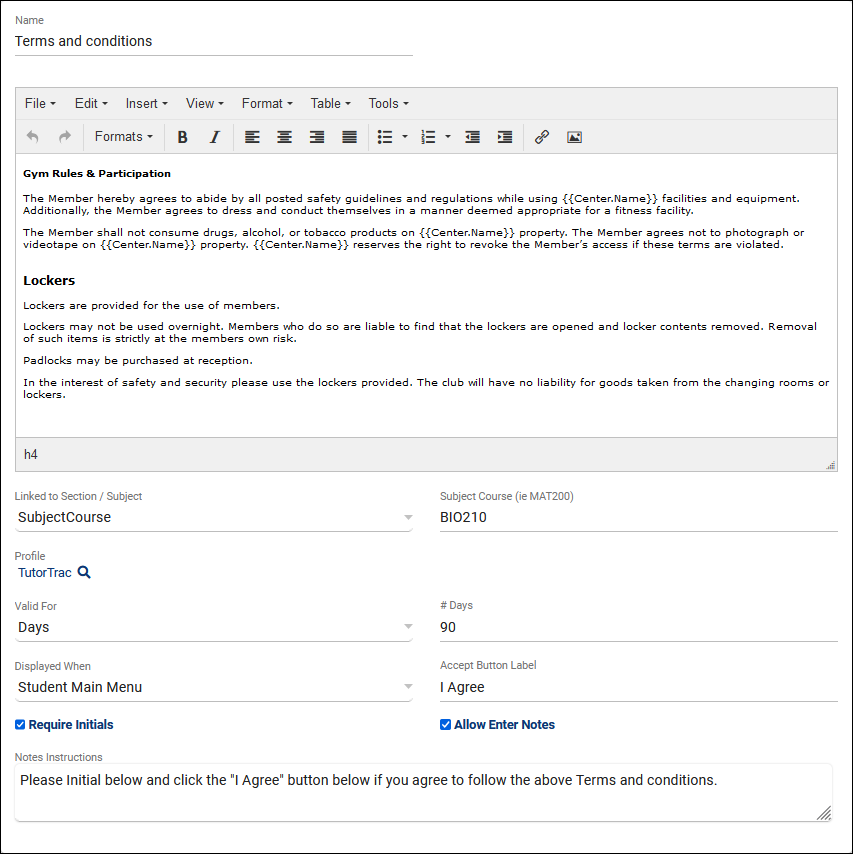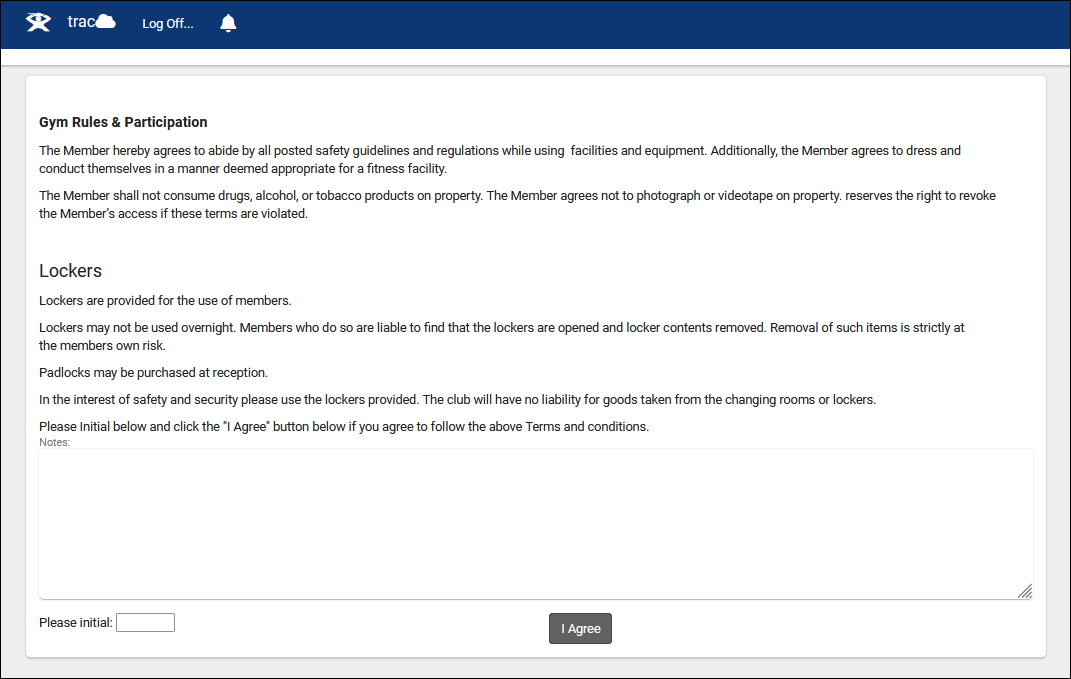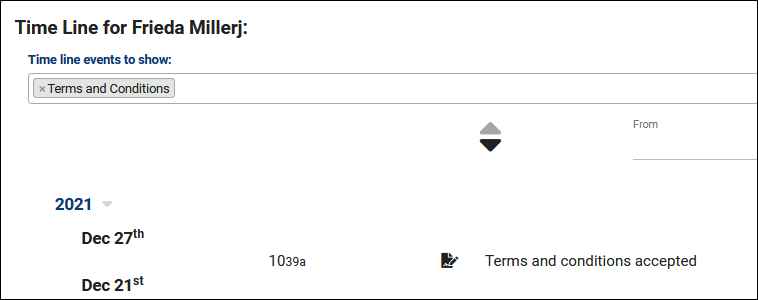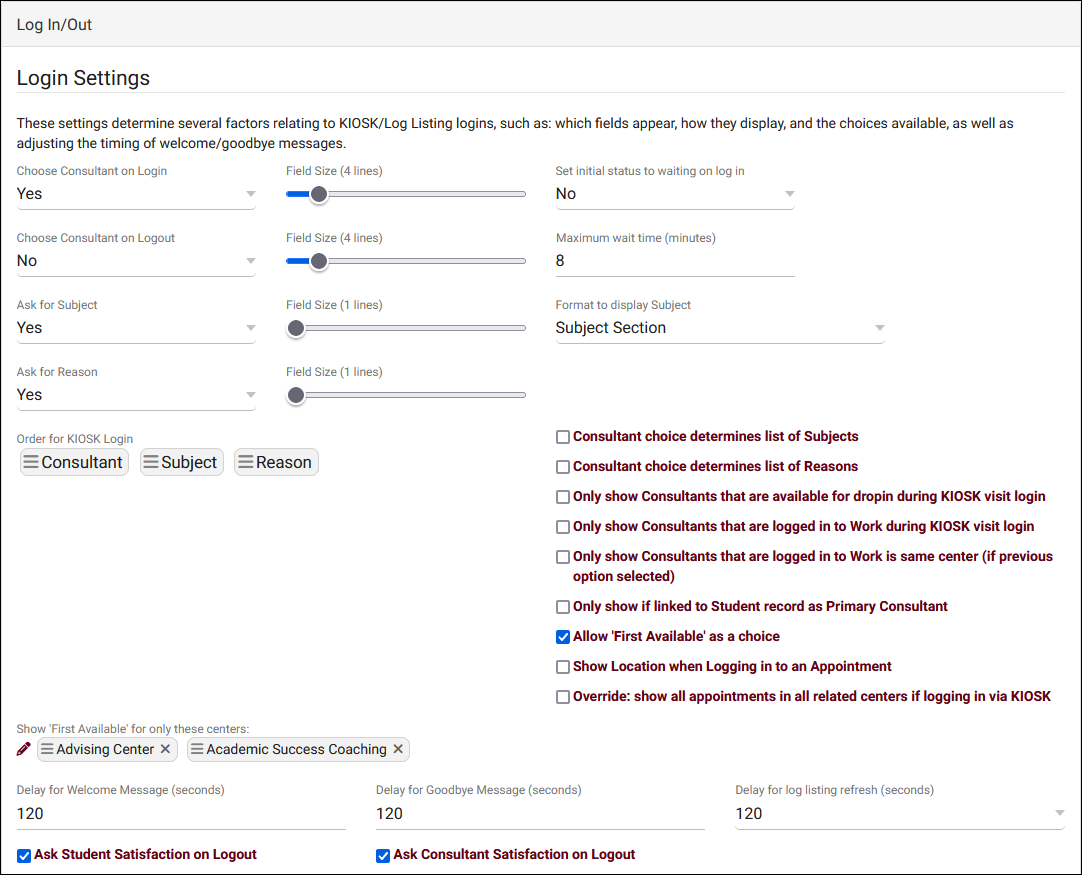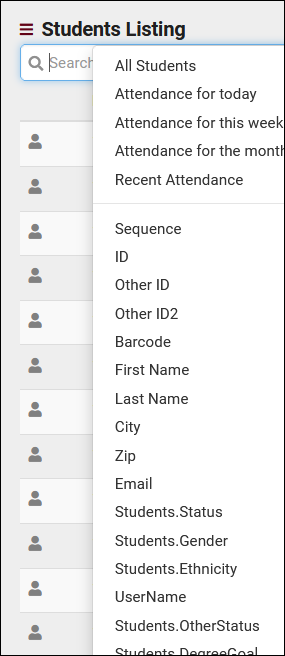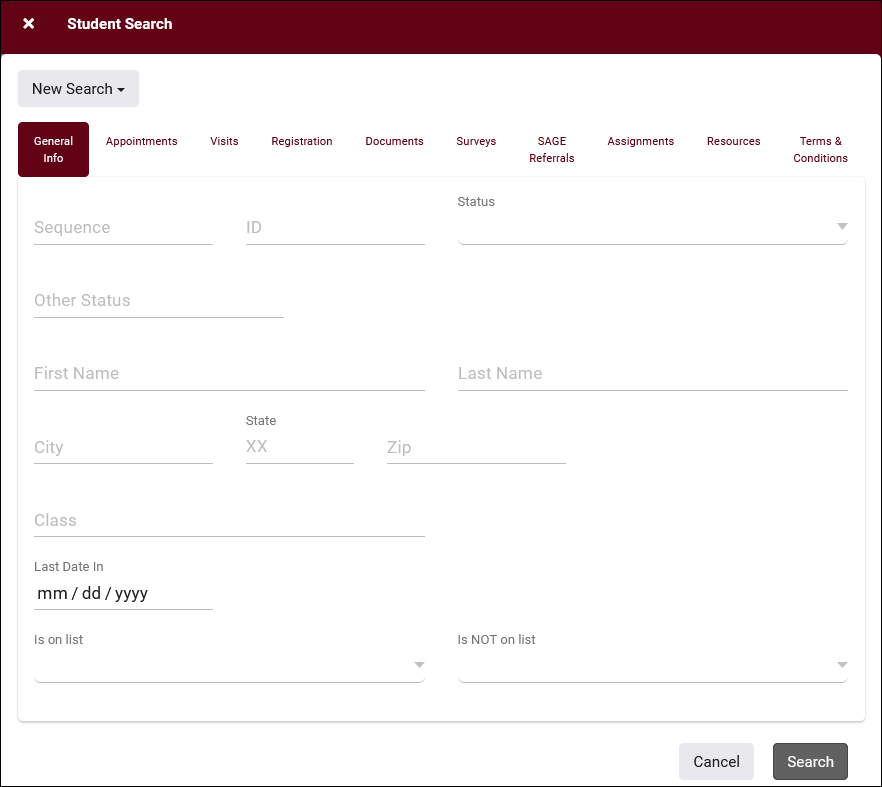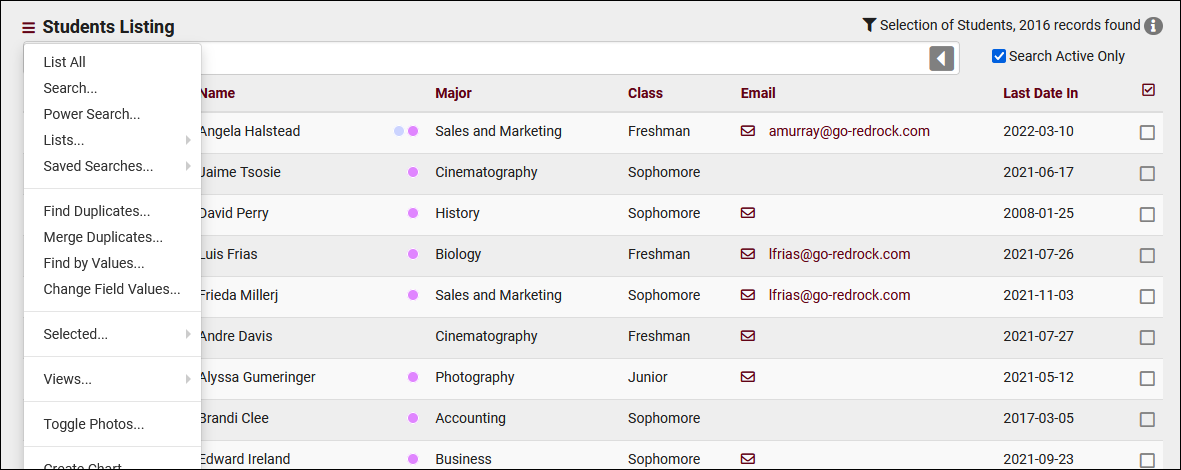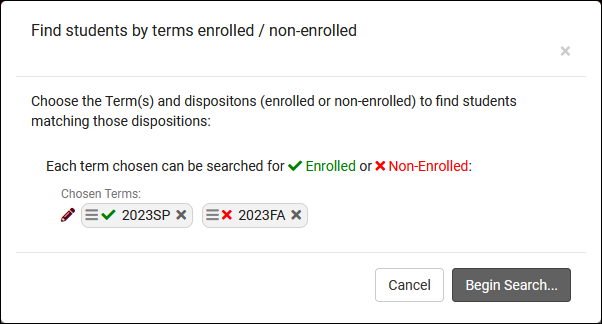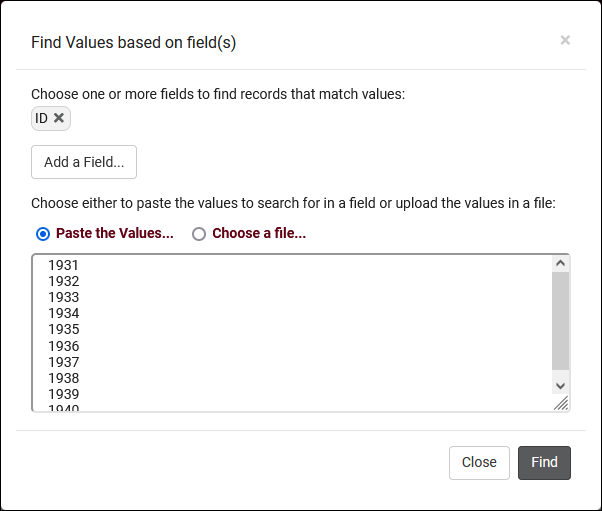TracCloudWhatsNew: Difference between revisions
From Redrock Wiki
No edit summary |
No edit summary |
||
| Line 12: | Line 12: | ||
<hr style="height:1px;border:none;color:#333;background-color:#333;" /> | <hr style="height:1px;border:none;color:#333;background-color:#333;" /> | ||
{{:TracCloudWhatsNew2021-12-27_1}} | {{:TracCloudWhatsNew2021-12-27_1}} | ||
<hr style="height:1px;border:none;color:#333;background-color:#333;" /> | |||
{{:TracCloudWhatsNew2021-12-21_1}} | |||
<hr style="height:1px;border:none;color:#333;background-color:#333;" /> | <hr style="height:1px;border:none;color:#333;background-color:#333;" /> | ||
{{:TracCloudWhatsNew2021-12-08_1}} | {{:TracCloudWhatsNew2021-12-08_1}} | ||
<hr style="height:1px;border:none;color:#333;background-color:#333;" /> | <hr style="height:1px;border:none;color:#333;background-color:#333;" /> | ||
Revision as of 18:57, 12 January 2022
This page highlights some of the recent changes made to the TracCloud platform, and how you can utilize them on your own instance. A list of past changes and a full changelog can be found in the tabs above.
If you have any questions about these changes, feel free to reach out to us on our helpdesk.
Terms & Conditions
Terms & Conditions allows you to create a prompt that appears for students when they're logging in or booking an appointment. The prompt will contain a custom message, which the student will have to agree to before continuing. While Terms/Conditions are of course the typical use-case, this feature can also be used for any purpose where a student would need to agree to a statement before having full access to the system.
1. Creating a new Term/Condition
Navigate to Other > Listings > Terms and Conditions. This will take you to the Terms and Conditions listing, where you can view or edit and previous entries. To create a new Term/Condition, click the hamburger icon and select New Terms and Conditions.

If your SysAdmin account doesn't have access to these options, jump to step 2 and apply those same changes to your SysAdmin group.
This will take you to the Terms and Conditions entry screen.
- Name
- This will be the title of this Term/Condition. This will be displayed across the top of the prompt when shown to students.
- This will be the title of this Term/Condition. This will be displayed across the top of the prompt when shown to students.
- Responses
- This will display a list of students who have accepted these terms/conditions and the date of acceptance.
- This will display a list of students who have accepted these terms/conditions and the date of acceptance.
- Text Entry Area
- This is where you can write out the text of this Term/Condition that students will need to agree to before continuing. If you wish to add custom field inputs to be answered by the student, this can be entered as {#custom:field_name#}. See example screenshots below. More information on custom fields can be found here.
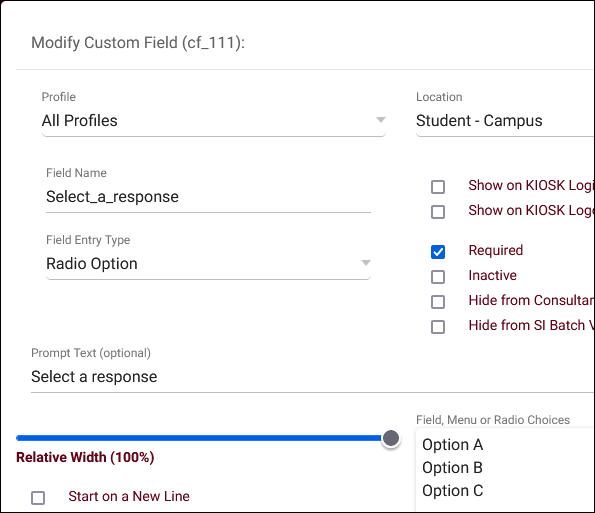
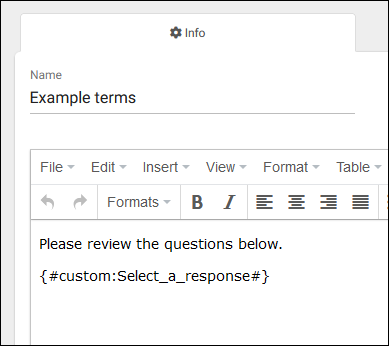
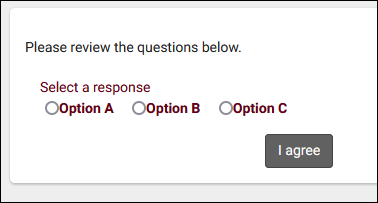
- Linked to Student List
- Only display these terms/conditions to students on the specified list.
- Only display these terms/conditions to students on the specified list.
- Linked to Section / Subject
- Terms and Conditions can be assigned to a specific subject, section, or all courses, depending on if this term/condition needs to be specific to a certain subject. If selected, an additional entry field will appear where you can choose the section/subject. This will only work with sections that students are registered for; non-enrolled courses will not trigger the terms/conditions to appear.
- Terms and Conditions can be assigned to a specific subject, section, or all courses, depending on if this term/condition needs to be specific to a certain subject. If selected, an additional entry field will appear where you can choose the section/subject. This will only work with sections that students are registered for; non-enrolled courses will not trigger the terms/conditions to appear.
- Profile / Center
- This is where you can assign this Term/Condition to a specific profile or center.
- This is where you can assign this Term/Condition to a specific profile or center.
- Valid For
- This option allows you to determine how long the Term/Condition agreement is valid for. There are three options.
- 1. Life – Never resets. Once Confirmed, the student will not see the Terms and Conditions again unless this option is changed.
- 2. Term – Resets after each semester. When next semester term switches over, the students will be asked again to agree to the Terms and Conditions once again.
- 3. Days - This option allows you set a custom length (e.g., 30 days, 90 days, etc).
- Displayed When
- This option determines where the student will see the Terms and Conditions prompt.
- 1. None - Inactive. This will deactivate this Term/Condition, and will no longer be displayed to students.
- 2. Student Main Menu - This will display as soon as the student logs into their account. Students will not be able to continue until the Terms/Conditions prompt has been confirmed.
- 3. Student Kiosk Login - This prompt will appear when a student attempts to login for a visit via a Kiosk, at which time they will be presented with the Terms and Conditions.
- 4. Student Booking Appointment - This prompt appears when a student selects an available time from the "Schedule an Appointment" widget on their dashboard. The Terms and Conditions must be confirmed before they can book an appointment.
- Accept Button Label
- This allows you to customize the name of the confirm button (e.g., "I agree").
- This allows you to customize the name of the confirm button (e.g., "I agree").
- Require Initials
- This requires the student to enter their initials before confirming, as a form of e-signature.
- This requires the student to enter their initials before confirming, as a form of e-signature.
- Allow Enter Notes
- This provides students the ability to enter in a note when filling out the Terms and Conditions.
- This provides students the ability to enter in a note when filling out the Terms and Conditions.
- Notes Instructions
- This is additional instructional text that will appear just above the notes field described above.
2. Group Settings
If you need to allow another set of staff members in your TracCloud instance to access/modify Terms and Conditions, you will need to apply a change to their permission group. Specifically, the Terms and Conditions option will need to be added to Table Access as seen below. This can either be set to View and Edit for full access, or View Only, if you don't want these users making any changes.
Other > Other Options > Groups > [The group you want to edit] > Admin / Modules > Table Access
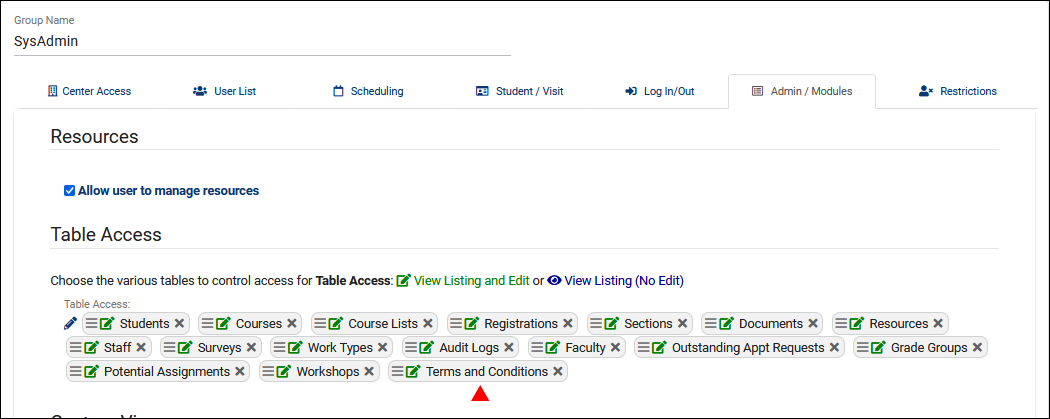
3. Example Configuration
The screenshot below shows an example of how Terms and Conditions can be configured, and how it displays to students.
Here's how that prompt looks to a student when logging into their account.
After the student agrees, the record of this agreement will appear in their Time Line as seen below.
4. Allowing Students to View Accepted Terms and Conditions
In order for students to be able to view terms and conditions that they've previously accepted, a system preference needs to be enabled. Go to Other > Other Options > Preferences > System Preferences > General Appointment Settings > Check "Allow students to view accepted Terms and Conditions on dashboard" > Save. Once enabled, students will see this button on their main menu next to the calendar URL. Clicking it will open a list of terms and conditions they've accepted, where they can see their response and the terms themselves by clicking on the arrow button.
Profile Preferences
Prefs
Log In/Out Preferences
The first section of our “Prefs” tab contains our Log In/Out preferences. These preferences control how the log listing displays, kiosk preferences, additional kiosk features, and more. This article will go through every preference in this menu, explaining exactly how they function.
Log In/Out
- Choose Consultant on Login
- Ask for Subject
- Ask for Reason
- Field Size
- These settings control which options appear during the login process, as well as how many options appear at once. As an example, the screenshot below matches the configuration above. Since we have the Reason choices set to 2, we can see 2 reasons at once in the login window, and can scroll down to see all available options. If Subject and Reason are enabled, they are inherently required. Consultant is optional unless "Yes (Required)" is chosen.
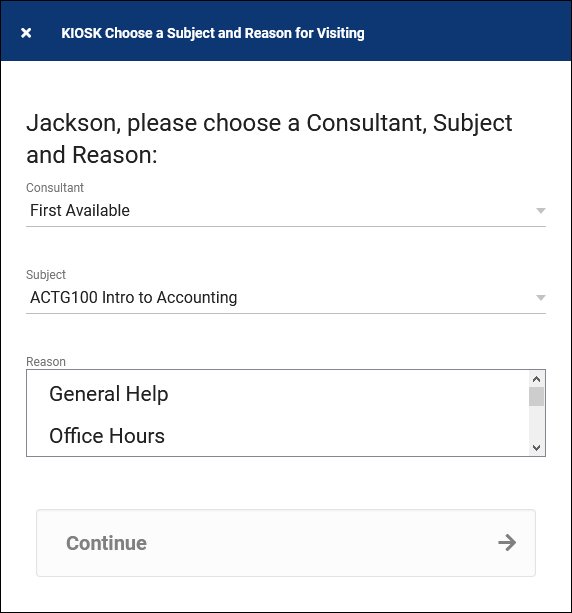
- Choose Consultant on Logout & # Choices
- If enabled, TracCloud will ask what consultant the student visited with while concluding their visit. Consultant is optional unless "Yes (Required)" is chosen. # of choices behaves just like the preference above.
- If enabled, TracCloud will ask what consultant the student visited with while concluding their visit. Consultant is optional unless "Yes (Required)" is chosen. # of choices behaves just like the preference above.
- Set initial status to waiting on log in
- If enabled, when a student logs in, the visit status will be “waiting” by default rather than immediately starting the visit with their consultant. This would be utilized when you need to keep track of wait time in addition to actual visit time.
- If enabled, when a student logs in, the visit status will be “waiting” by default rather than immediately starting the visit with their consultant. This would be utilized when you need to keep track of wait time in addition to actual visit time.
- Maximum wait time
- When this time limit is reached, the “Wait Time” counter on the Log Listing/Kiosk changes color to be more noticeable.
- When this time limit is reached, the “Wait Time” counter on the Log Listing/Kiosk changes color to be more noticeable.
- Format to display Subject
- This preference controls how the subject field is displayed during the login process. For example, you can choose to only display the Subject (MAT500) or the Title (Introduction to Example), or you can include the full Subject Section Title (MAT100 01 Introduction to Example) if needed.
- This preference controls how the subject field is displayed during the login process. For example, you can choose to only display the Subject (MAT500) or the Title (Introduction to Example), or you can include the full Subject Section Title (MAT100 01 Introduction to Example) if needed.
- Order for KIOSK Login
- This preference controls the order of questions asked during the login process. For example, if you want the student/staff to select a consultant first, then select a subject that the consultant can assist with, you would put “Consultant” prior to “Subject” in this section. This also works in reverse, if you want you want to select a subject first, then a consultant that is able to assist.
- This preference controls the order of questions asked during the login process. For example, if you want the student/staff to select a consultant first, then select a subject that the consultant can assist with, you would put “Consultant” prior to “Subject” in this section. This also works in reverse, if you want you want to select a subject first, then a consultant that is able to assist.
- ________ choice determines list of ________
- This preference changes depending on the KIOSK order defined above. If you choose subject before consultant, these checkboxes ask if you want to let the staff/student’s Subject choice determine the list of consultants, based on the consultants assigned course list.
- This preference changes depending on the KIOSK order defined above. If you choose subject before consultant, these checkboxes ask if you want to let the staff/student’s Subject choice determine the list of consultants, based on the consultants assigned course list.
- Only show Consultants that are available for dropin during KIOSK visit login
- If enabled, only consultants that have a currently available drop-in availability will appear in the Consultant box.
- If enabled, only consultants that have a currently available drop-in availability will appear in the Consultant box.
- Only show Consultants that are logged in to Work during KIOSK visit login
- If enabled, only consultants who are currently logged in for a Work visit will appear in the consultant choice box.
- If enabled, only consultants who are currently logged in for a Work visit will appear in the consultant choice box.
- Only show Consultants that are logged in to Work is same center (if previous option selected)
- A more strict version of the above option, only showing consultants who are logged in for work in the center that the student is attempting to log in to.
- A more strict version of the above option, only showing consultants who are logged in for work in the center that the student is attempting to log in to.
- Only show if linked to Student record as Primary Consultant
- Students can be imported with a linked "PrimaryConsultantID" value, and enabling this preference will only show that consultant on login. This is separate from the linked advisor settings found in your centers, and should typically be left unchecked.
- Students can be imported with a linked "PrimaryConsultantID" value, and enabling this preference will only show that consultant on login. This is separate from the linked advisor settings found in your centers, and should typically be left unchecked.
- Allow ‘First Available’ as a choice
- If enabled, “First Available” will be an available consultant choice during the login process. A consultant can be selected during the Waiting to Started visit status change, during the logout process, or manually changed within the student’s visit record after the fact. Show 'First Available' for only these centers will also appear if this is enabled, allowing you to select which centers "First Available" will be available in.
- If enabled, “First Available” will be an available consultant choice during the login process. A consultant can be selected during the Waiting to Started visit status change, during the logout process, or manually changed within the student’s visit record after the fact. Show 'First Available' for only these centers will also appear if this is enabled, allowing you to select which centers "First Available" will be available in.
- Show Location when Logging in to an Appointment
- When a student logs in on a Kiosk near the start time of their appointment, the student will be asked if they're logging in for that appointment to help speed up the login process (and to link the Visit record to the Appointment). Enabling this option will include the Location of their appointments in this prompt.
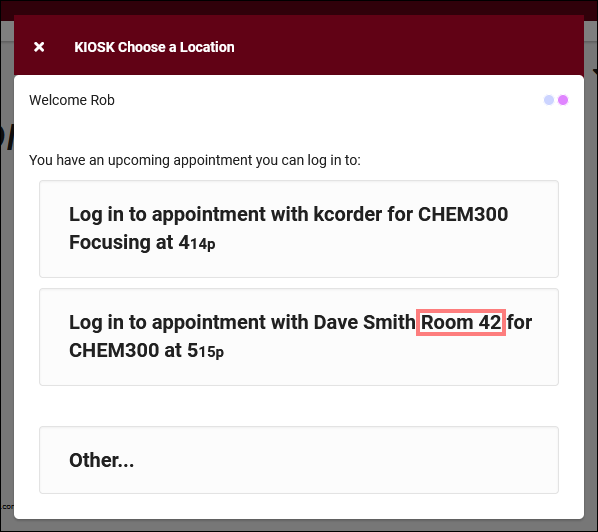
- Override: show all appointments in all related centers if logging in via KIOSK
- If enabled, students will be allowed to login to other centers from a specific center's kiosk. This is generally not recommended.
- If enabled, students will be allowed to login to other centers from a specific center's kiosk. This is generally not recommended.
- Delay for Welcome and Goodbye Message (seconds)
- Controls how long the Login and Logout prompts on Kiosks and Log Listings display before automatically closing. For example, if a student starts logging in and walks away from the Kiosk before completion, you may want the menu to close after 30 seconds of inactivity to allow the next student to login normally.
- Controls how long the Login and Logout prompts on Kiosks and Log Listings display before automatically closing. For example, if a student starts logging in and walks away from the Kiosk before completion, you may want the menu to close after 30 seconds of inactivity to allow the next student to login normally.
- Delay for log listing refresh (seconds)
- This setting controls the frequency of automatic log listing refreshes, allowing you to see the most up to date visit data.
- This setting controls the frequency of automatic log listing refreshes, allowing you to see the most up to date visit data.
- Ask Student Satisfaction on Logout & Ask Consultant Satisfaction on Logout
- Enabling these options adds a "please rate your satisfaction" question to the logout process of both the log listing *and* kiosk. These responses are only accessible to groups who have been provided access to these fields in the 'Student / Visit' tab. Responses will be visible on the student listing and in reports such as Visits by ??.
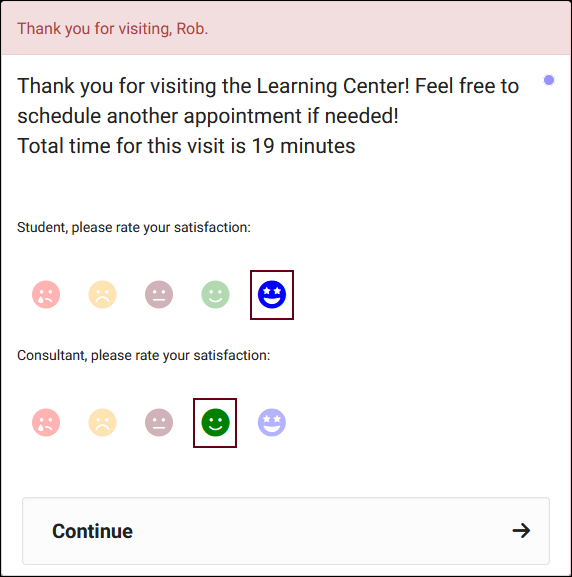
- Log List Customization
- These settings determine what and how information is displayed on the Log Listing, from both the staff and Kiosk point of view. More information on customizing this view along with more examples can be found in its own dedicated article.
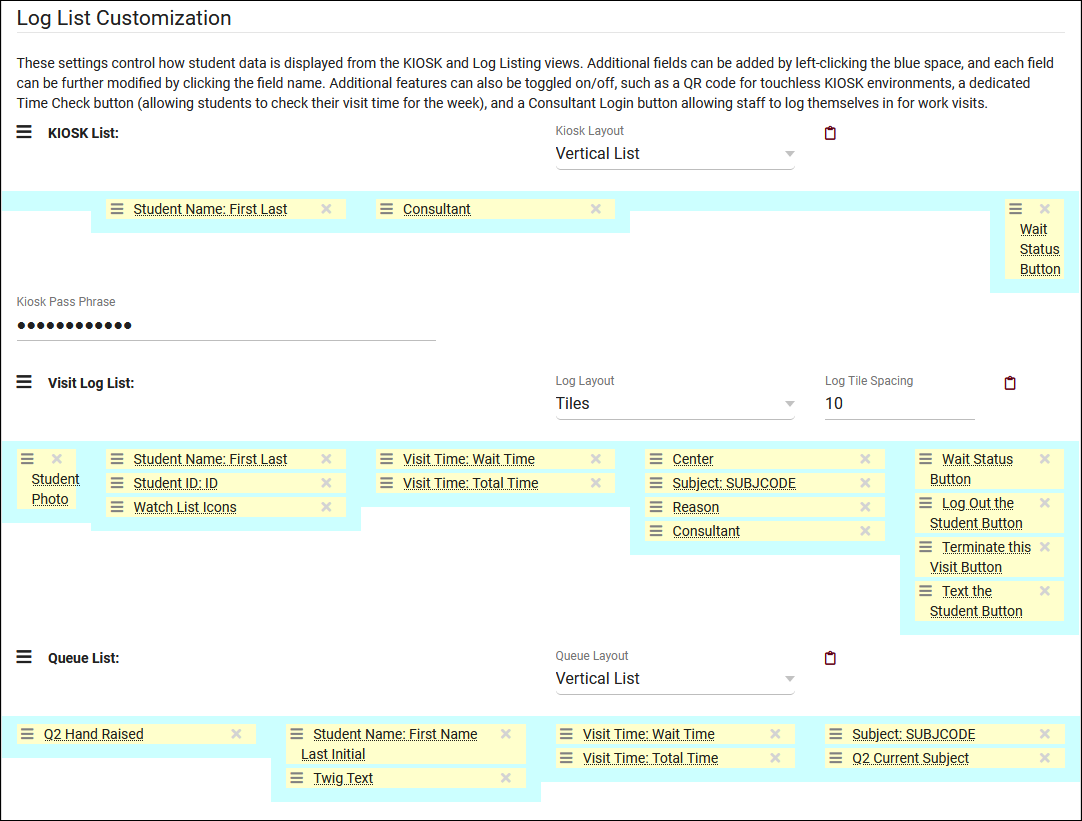
- Show Touchless QR Code for KIOSK Student Signin on Phone
- This preference adds a QR code to your Kiosk. Students can scan this with their phones, which will take them to a URL where they can enter their ID to login/logout. This QR code automatically regenerates after several minutes, so students can’t keep the URL for later use. QR Code Width allows you to adjust the size of the QR code on your screen.
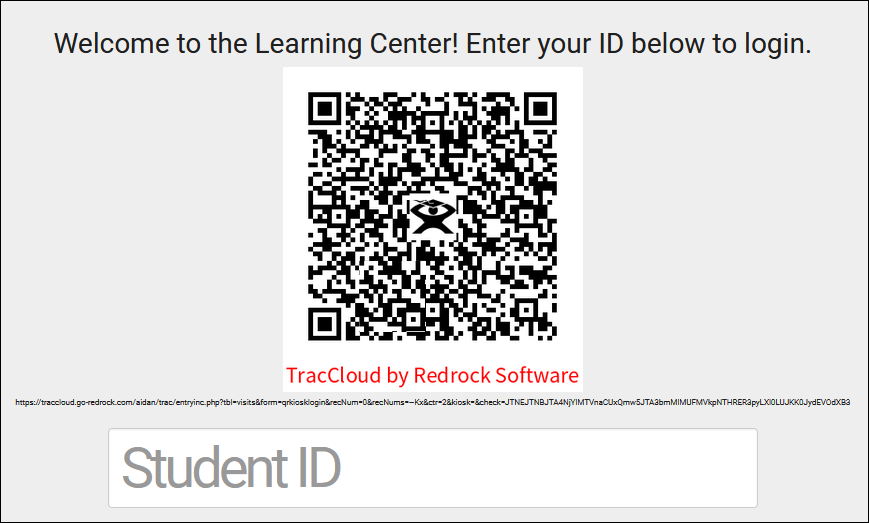
- QR Code is clickable
- If checked, the kiosk QR code can be clicked on to open the login form. This option is typically disabled.
- If checked, the kiosk QR code can be clicked on to open the login form. This option is typically disabled.
- Show Queue and Consultant login buttons
- This preference adds separate login prompt on the log listing and kiosk for work visits. If selected, users are prompted to enter their IDs, and as long as they have a valid consultant account, they can directly login for a work visit. Allow Consultant Login for Custom KIOSKs as well also enables this feature on Custom Kiosks. This additionally enables the "Queue" button on the Log Listing to view a more restricted list of students who are logged in (typically for a queue TV).
- This preference adds separate login prompt on the log listing and kiosk for work visits. If selected, users are prompted to enter their IDs, and as long as they have a valid consultant account, they can directly login for a work visit. Allow Consultant Login for Custom KIOSKs as well also enables this feature on Custom Kiosks. This additionally enables the "Queue" button on the Log Listing to view a more restricted list of students who are logged in (typically for a queue TV).
- Prevent Login Via Name
- If checked, it will not be possible to log a student in on the Log Listing or Kiosk by name (e.g., 'Sam Smith'). ID, Barcode, etc, must be used instead.
- If checked, it will not be possible to log a student in on the Log Listing or Kiosk by name (e.g., 'Sam Smith'). ID, Barcode, etc, must be used instead.
- Require Single Record Found
- Typically used if Prevent Login Via Name is unchecked. This requires that any Log Listing/Kiosk login attempts must return only a single student to continue. If unchecked, a student might search for 'Dave' to login, and scroll through other existing students to find their own name. Checking this box would prevent that, requiring that the student be specific enough to only return a single applicable student profile to continue.
- Typically used if Prevent Login Via Name is unchecked. This requires that any Log Listing/Kiosk login attempts must return only a single student to continue. If unchecked, a student might search for 'Dave' to login, and scroll through other existing students to find their own name. Checking this box would prevent that, requiring that the student be specific enough to only return a single applicable student profile to continue.
- Allow User to Generate a Prospect
- Adds an option to the log listing and kiosk pages to create new prospective student accounts. Requires additional configuration in global settings, click here to learn more.
- Adds an option to the log listing and kiosk pages to create new prospective student accounts. Requires additional configuration in global settings, click here to learn more.
- Label of Button
- Optionally override the name of the button on the log listing/kiosk to create a new prospective student record.
- Optionally override the name of the button on the log listing/kiosk to create a new prospective student record.
- Label of Subtitle
- Optionally override the subtitle/description that appears when the "New Prospective Student" button is clicked on the log listing/kiosk.
Students Listing
Student data is one of the most important parts of your Trac System, on top of being the record that all their visits, appointments, documents, and more are assigned to, you also have the student's information directly. You can run reports on visits grouped by student majors, or send emails to students of a certain class, cohort, or any other field you have available. This article goes over some of the ways you can search for these records.
The Students Listing itself (found by clicking 'Students' in the Navigation Bar) contains all student records uploaded to your Trac System. From this page, we're able to manage student data in bulk, creating lists, sending emails, or submitting SAGE referrals, or we can open a specific student record and manage just one student profile at a time.
Each column of information displayed has a clickable header that will sort the listing accordingly. Clicking once sorts ascending, a second click will sort descending.
Using the Search Bar on this screen, we can easily perform quick searches to find specific students. Right clicking in the search bar (shown below) will provide a list of available student fields to search, click any of these to auto-fill the search bar.
Example Searches:
- Find a student by a single value, such as ID. Specifying 'Students.ID=' actually isn't required for ID or Name searches, but it works well as an example.
- Students.ID=1931
- Students.ID=1931
- ...or name. Names should be formatted as 'Last, First' or 'First M Last'. 'First Last' will also work if middle names are not being imported.
- Day, Rob
- Day, Rob
- Search multiple fields at once, separate your searches by a space.
- Students.Major=Mathematics Students.Class=Sophomore
- Students.Major=Mathematics Students.Class=Sophomore
- When performing multiple searches where at least one field contains a space, make sure to surround the contents you're searching for with quotation marks.
- Students.Major="Chemical Engineering" Students.Status=Active
- Students.Major="Chemical Engineering" Students.Status=Active
- Search in Custom Fields. It's recommended to use the right-click menu to select these, as it will always auto-fill the correct field name.
- #sql:InState#=Yes
- #sql:InState#=Yes
- Date searches such as this are required to be formatted as YYYY-MM-DD
- Students.BirthDate=1993-07-16
- Students.BirthDate=1993-07-16
- We also offer a special search to find students where today is their birthday.
- birthdaytoday
- birthdaytoday
Students Search
The Student Listing also has a unique Search utility found in the hamburger menu . This utility has the ability to search related tables to find relevant students. This includes the ability to run searches such as "students who have had appointments in the last 7 days" or "students who have ongoing referrals."
- Search Type
- This can be set to New Search, Search Selection, Remove found from Selection, or Add found to Selection, depending on the desired effect of this search.
- General Info tab
- This tab is where you can search for basic information about the student. ID, Status, Name, etc.
- Appointments
- This tab allows you to search for students by appointment information. For example, "students who had an appointment from 02/10 to 02/20 with a status of Missed." Any fields that support wildcards additionally support the | character for "or."
- Visits
- This tab allows you to search for students by visit info. For example, "students who visited more than 2 times from 02/10 to 02/20 where the subject was MAT100." Any fields that support wildcards additionally support the | character for "or."
- Registration
- This tab allows you to search for students by registration info. For example, "students who are actively enrolled in more than one math course." Any fields that support wildcards additionally support the | character for "or."
- Documents
- This allows you to search for students by documents. "Students who have a document of a certain filename uploaded in the last month."
- Surveys
- Students who have received or responded to a survey in a certain time period. Requires SurveyTrac.
- SAGE Referrals
- Students who have ongoing or completed referrals of a specific type in a specified date range. Requires SAGE. Any fields that support wildcards additionally support the | character for "or."
- Assignments
- This tab allows you to search by potential assignments. Any fields that support wildcards additionally support the | character for "or."
- Resources
- This tab allows you to search for students by their resource usage, whether they have certain items checked out or overdue. Any fields that support wildcards additionally support the | character for "or."
- Terms & Conditions
- Search by accepted terms and conditions. Any fields that support wildcards additionally support the | character for "or."
- Success Plans
- Search by assigned Success Plans.
Hamburger Menu
Every listing page in the Trac System features a hamburger menu with utilities to search for or interact with your list of records. Some of these options are specific to a certain listing/record-type, others are shared. The following list includes definitions for the hamburger menu options available on this listing, and how they can be utilized.
- List All
- This option will show all records on the current listing. Some listings have an additional toggle for only showing "Active" records, such as Students and Registrations, which will still override a "List All" search if checked.
- This option will show all records on the current listing. Some listings have an additional toggle for only showing "Active" records, such as Students and Registrations, which will still override a "List All" search if checked.
- Search
- This utility will open a pop-up window unique to each Listing it's present on, allowing you to search your records by a number of different fields. In the case of the Student Listing, you could use this to search related records, such as 'Students who have at least 2 Visits in the Learning Center' or 'Students with a recent Document upload in their timeline.'
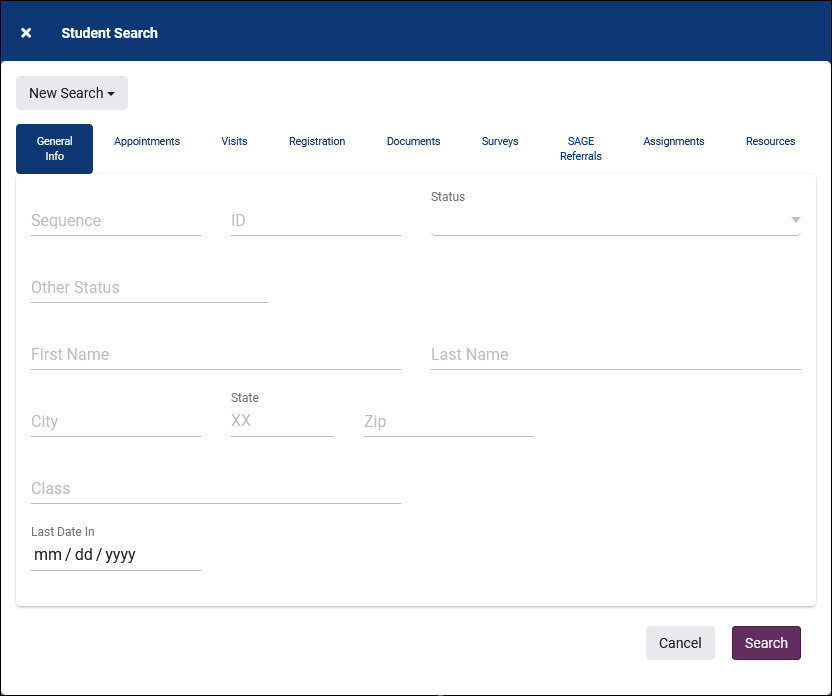
- Power Search
- This option provides a simple but powerful search utility to find the records you need. String together multiple searches, adding or removing results for each. Use Search Symbols to include ranges of data, and Save Searches for later use if needed. The search term 'blankornull' can be used to find all records with a value of nothing ("") or null ().
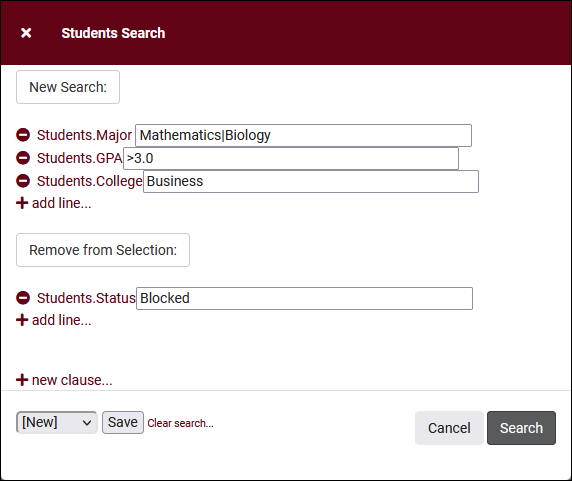
- Search by Term Enrollment
- Lists
- See Student Lists and Watch Lists for more information.
- See Student Lists and Watch Lists for more information.
- Saved Searches
- See Saved Searches for more information.
- See Saved Searches for more information.
- Find/Merge Duplicates
- These utilities can be used to cleanup duplicate records in your Trac System. We highly recommend reaching out to Redrock Support directly for assistance in cleaning up this data.
- These utilities can be used to cleanup duplicate records in your Trac System. We highly recommend reaching out to Redrock Support directly for assistance in cleaning up this data.
- Find by Values
- Change Field Values
- This utility allows you to make modifications in to your records in bulk. Similar to the Merge Duplicates utility, we highly recommend coordinating with Redrock Support directly on this setting.
- This utility allows you to make modifications in to your records in bulk. Similar to the Merge Duplicates utility, we highly recommend coordinating with Redrock Support directly on this setting.
- Selected...
- The Selection Tool offers several options to filter and manage your records. More information on this feature can be found in its own dedicated article here.
- The Selection Tool offers several options to filter and manage your records. More information on this feature can be found in its own dedicated article here.
- Views
- See Views for more information.
- See Views for more information.
- Send Survey
- Allows you to send a survey to the current user list. More information.
- Allows you to send a survey to the current user list. More information.
- Register In
- Allows you to quickly enroll a student in a new registration. Depending on your import configuration, manually recreated registrations may be deactivated during your auto-import.
- Allows you to quickly enroll a student in a new registration. Depending on your import configuration, manually recreated registrations may be deactivated during your auto-import.
- Assign Success Plan
- Allows you to assign a new Success Plan to the current student list. More information.
- Allows you to assign a new Success Plan to the current student list. More information.
- Create Referral
- Allows you to create a batch referral through SAGE. More information.
- Allows you to create a batch referral through SAGE. More information.
- Create Task
- Allows you to send a task to the current student list. More information.
- Allows you to send a task to the current student list. More information.
- Toggle Photos
- Enable or disable student photos on the Student Listing.
- Enable or disable student photos on the Student Listing.
- Create Chart
- Based on the data currently being viewed a chart can be generated to visually illustrate the relationships in the data.
- Based on the data currently being viewed a chart can be generated to visually illustrate the relationships in the data.
- Export CSV
- Export current listing contents to a CSV file.
- Export current listing contents to a CSV file.
- Send Email
- Allows you to send an email directly to a list of users.
- Allows you to send an email directly to a list of users.
- Send Email to Faculty
- This email utility allows you to email faculty linked to student registrations. The faculty recipients can be determined by subject, status, and grade. One email will be sent per linked registration, so if there are 3 students listed enrolled in MAT100 with Dave Smith, Dave Smith will receive 3 emails. Faculty recipients can also be filtered by scheduled day/time if section schedule is being imported.
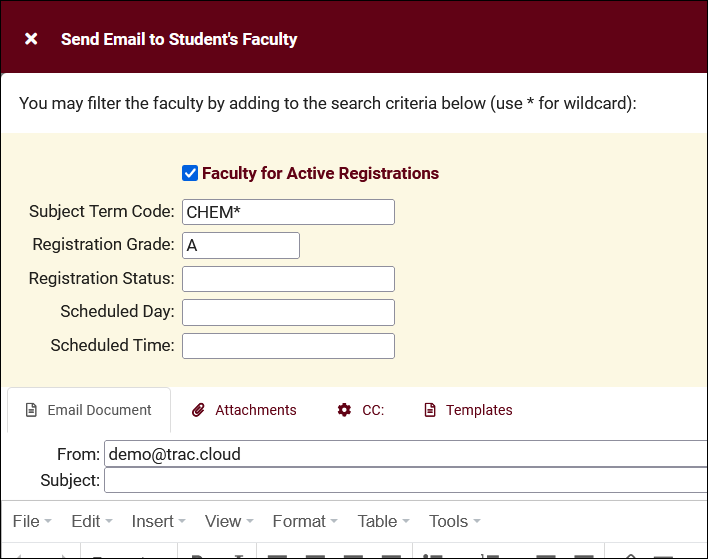
- Show these <records>
- This utility takes your selection of records, finds the related records, and takes you to that listing with the resulting records. For example, on the Registration listing, you can "Show these Students" to display the student records for the registrations that you were viewing.
- This utility takes your selection of records, finds the related records, and takes you to that listing with the resulting records. For example, on the Registration listing, you can "Show these Students" to display the student records for the registrations that you were viewing.
- Allows you to print the contents of the current listing, by extension this also allows you to export the current list as a PDF file.
- Allows you to print the contents of the current listing, by extension this also allows you to export the current list as a PDF file.
- New <Record>
- Allows you to create a new record based on your selected listing.
- Allows you to create a new record based on your selected listing.
See Also


